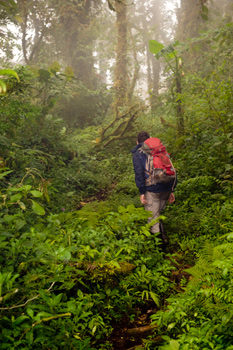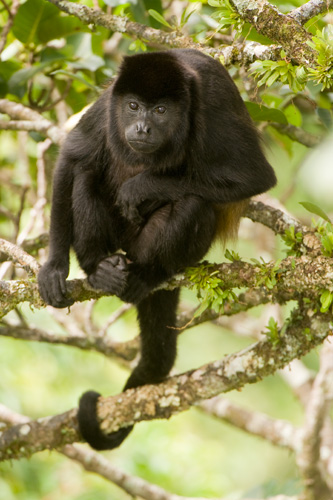An Introduction To Tropical Montane Cloud Forests

Clouds in the forest can extend all the way down to the ground.
What Is A Tropical Montane Cloud Forest?
There is not an agreed upon definition of what makes a cloud forest a cloud forest. However, cloud forests are generally defined by their constant immersion in a layer of clouds. Here, we are interested in cloud forests that form along mountainsides (generally between 1,000 and 3,000 meters (3,300-9,850 feet), but as low as 500 meters (1,650 feet)) in the Tropics (between the latitudes 23°N and 23°S).
How Do The Clouds Form?
The process of forming clouds takes several steps. First, water evaporates off the sea or land surface, forming a warm mass of air. Next, the air mass is carried by winds until it strikes the side of the mountain. As the wind forces the mass of air and water vapor up the side of the mountain, it cools, and the water vapor begins to condense, forming water droplets that appear as clouds.
Where Do They Occur?
Tropical montane cloud forests are very rare and represent only a fraction of the world's remaining tropical forests. The best current estimate is only 0.14% of the entire land surface of the planet. In addition to Central America, tropical montane cloud forests are found in South America, Africa, Southeast Asia, and the Caribbean. There's even cloud forest on the side of Mt. Kilimanjaro in Tanzania.

A common mantled howler monkey (Alouatta palliata) rests in a fig tree amidst a meal.
What Makes Them Special?
Since they are almost always covered in clouds, tropical montane cloud forests have very unique climate conditions. This affects the plants and animals living in the forest and the ecosystem as a whole.
Tropical montane cloud forests are home to an incredible number of plant and animal species. In Monteverde, Costa Rica alone, there are approximately 750 tree species, and this number will likely grow as rare new species are discovered. In comparison, all of North America (north of Mexico) has approximately 1000 tree species. Many tropical montane cloud forests have high rates of endemism (species that don't occur anywhere else).
Why Are They A Conservation Priority?
These rare ecosystems are valuable for their beauty and biodiversity conservation, but they also have value to those living around them. They maintain water cycles, provide food sources, and are often attractive centers of tourism and thus provide people with their livelihoods.
Unfortunately, tropical montane cloud forests are threatened by a number of pressures. These include the cutting of forest for wood and cattle grazing, climate change, hunting, and tourism. As people need more and more resources to survive, the threats to these forests increase.
Climate change is among the biggest concerns in the tropical montane cloud forests. New research suggests that the timing, strength, and frequency of cloud cover is changing due to rising temperatures. These cloud cover changes have been associated with local extinctions and changes to populations of rare bird, frog, and salamander populations. New climate models suggest that in the next 50-100 years, cloud forests may get warmer and drier at rates that they have never before experienced.
References:
Bruijnzeel, L.A. 2010. Tropical Montane Cloud Forests. Cambridge University Press, Cambridge, UK.
Bruijnzeel, L.A. 2005. Tropical montane cloud forest: a unique hydrological case. In: (M. Bonell & L.A. Bruijnzeel, eds.), Forests, water and people in the humid tropics. University Press, Cambridge, UK. Pp. 462-484.
Bubb, P., I. May, L. Miles, & J. Sayer 2004. Cloud forest agenda. UNEP-WCMC, Cambridge, UK. 36p.
Hamilton, L.S., J.O. Juvik, & F.N. Scatena. 1995. The Puerto Rico tropical cloud forest symposium: introduction and workshop synthesis. In: (L.S. Hamilton, J.O. Juvik, & F.N. Scatena, eds.), Tropical montane cloud forests, ecological studies 110. Springer-Verlag, New York, USA. Pp. 1-24.
Lawton, R.O., U.S. Nair, R.A. Pielke Sr., & R.M. Welch. 2001. Climatic impact of tropical lowland deforestation on nearby montane cloud forests. Nature 294: 584-587.
Nadkarni, N.M. & N.T. Wheelwright. 2000. Monteverde: ecology and conservation of a tropical forest. Oxford University Press, New York, USA. 608 p.
Pounds, J.A., M.P.L. Fogden, & J.H. Campbell. 1999. Biological response to climate change on a tropical mountain. Nature 398: 611-615.
Pounds, J.A., M.R. Bustamente, L.A. Coloma, J.A. Consuegra, M.P.L. Fogden, P.N. Foster, E. La Marca, K.L. Masters, A. Merino-Viteri, R. Puschendorf, S.R. Ron, G.A. Sanchez-Azofeifa, C.J. Still, & B.E. Young. 2006. Widespread amphibian extinctions from epidemic disease driven by global warming. Nature 439: 161-167.
